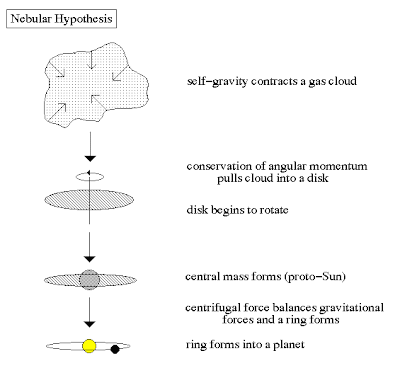ORIGIN OF SOLAR
SYSTEM- Theories
The solar system (Disigned by http://www.learningbygrace.org/releases/pluto.php)
According to modern research, there are eight planets, ninth planet which was PLUTO is not considered as planet. Therefore, eight planets and the sun are
the main bodies of the solar system. Whereas, planets are concerned, on the
basis of their location they can be divided into two groups. (i) Inner
planets (Terrestrial) which include Mercury, Venus, Mars and Earth. They
are of small size, high density, their composition is silicates, metals and
their rate of rotation is very high. (ii) Outer planets (Jovian) which
include Jupiter, Saturn, Uranus and Neptune. These planets are of large
size, low density and their rate of rotation is very slow.
The theories of origin of solar system
can be divided into two groups:
ð
Evolutionary Theories: The theories, which suggest that planets are formed
during the evolution of sun, are called evolutionary theories.e.g:
Nebular Hypothesis.
ð
Catastrophic Theories: The theories, which suggest that planets are formed
by some special accidents, such as by collision of two stars.e.g:
Planetesimal, binary star and Gaseous Tidal Hypothesis.
NEBULAR
HYPOTHESIS:
A vast cloud of hot gas is called nebula. The nebular hypothesis,
developed by Immanuel Kant in 1755 and Laplace in 1796. According to this
hypothesis, “the sun and planets have formed from disc-shaped rotating nebula”.
Nebular Hypothesis (http://abyss.uoregon.edu/~js/ast121/lectures/lec24.html)
The nebular hypothesis may be summarized as the nebula rotated and
contracted, rings of gas were cast off at various stages from which the planets
subsequently condensed.
PLANETESIMAL
HYPOTHESIS: According
to Moulton (1901) and Chamberlin (1901) the solar system originated from
matter, which was in form of tiny dust, grains called “Planetesimals”.
The planets
evolved from a cloud of planetesimals, which revolve around the sun. The
planetesimals, the tiny cosmic fragments collided with each other and united together
to form larger bodies, which became planets and satellites revolving around the
sun.
GASEOUS
TIDAL HYPOTHESIS: Jean (1919) and Jeffrey (1925) postulated gaseous tidal hypothesis.
This hypothesis states “A big star during its course of wandering in the space
approached the sun and caused violent tidal distortion in the sun by its very
strong gravitational pull”.
As it
came very close to the sun, parts of the sun affected by strong tide were
pulled away in the form of a spindle shaped filament, which was in unstable
state. Then, as the big star receded away, this unstable filament broke away
into pieces of hot and gaseous masses. Few of them were carried away along with
the receding star; while major bulk of them fell into the gravitational field
of sun. They formed globular masses orbiting the sun. The bigger masses
gradually cooled down and concentrated to planets. The smaller masses
solidified into satellites. One of the planets further broke away into pieces
called asteroids/planetoids.
BINARY
STAR HYPOTHESIS: This hypothesis was put forwarded by Lyttleton in 1938. Our solar
system was born from one of these star pairs, which consisted of the sun and
another smaller star known as the companion star.
A
huge-sized third star came into the region of this paired stars and caused
tidal explosions in the companion star which was completely disrupted, When the
third star came close to the companion star some parts of the companion star,
were carried away along with the third star which eventually receded away. The
rest fell into the sun’s gravitational control, these parts retained by the sun
revolved round it and gradually cooled down to form the planets.
CLICK THE LINK BELOW FOR MORE NOTES AND KNOWLEDGE ON
GEOLOGY

